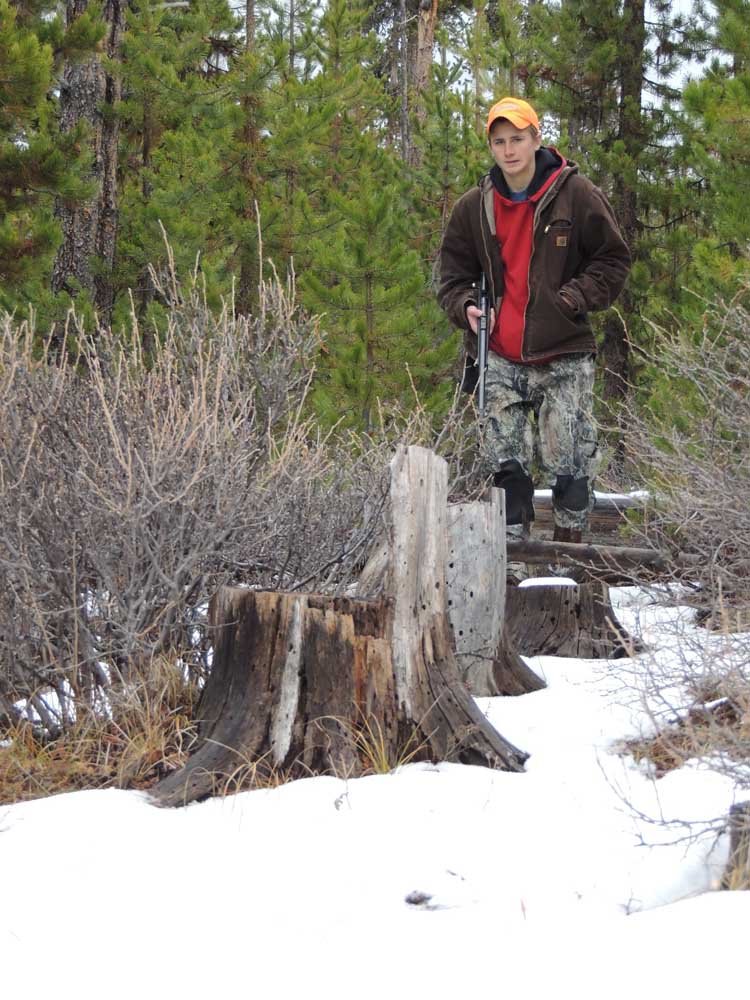Scouting Cascades elk by wildfire footprints
Published 12:00 am Monday, October 1, 2018

- Paxton Eicher, of Bend, hunting elk in the Cascades. October can bring early snow, which is certainly always very welcome in elk season. The Cascade hunt begins Oct. 13 and runs through Oct. 19. (Gary Lewis/Bulletin photo)
When the forecast called for snow, I laced my boots and grabbed the rifle. My friend Charlie was waiting on a forest road. It was the last day of the season, and we had 4 inches of snow.
We parked the Ford at a closed road and worked up into the timber in the fresh powder. A mile in, I found a turned-over mushroom and the tracks of a lone bull.
For most of an hour, we played hide-and-seek with the elk. His tracks told us he turned to listen to elk talk, but he didn’t come toward us. Then the wind changed and blew away my chances of turning my elk tag into elk roasts.
According to the numbers, 4 percent of hunters in the Upper Deschutes Unit filled their tags last year. I am in the 96 percent.
I can’t help but remember what ODFW biologist Steve Niemela told me once. “In any given year, 95 percent of people are not going to get their elk,” he said. “A hunter can do everything right and still not get a bull.”
Yep, most years, that’s me.
The Cascades bull elk hunt takes in nine units on both sides of the Pacific Crest Trail and parts of three other units. With high percentages of public land, this is at once Oregon’s most accessible and lowest percentage elk hunt opportunity.
The Indigo, McKenzie, Rogue, Santiam and Upper Deschutes units produce the most bulls each season.
In terms of harvest success, last year’s best bets were the Evans Creek (9 percent successful), Metolius (9 percent) and McKenzie (7 percent) units.
In the Cascades, the elk are often on a five- to seven-day rotation that can put them 10 miles away from the other end of their home range.
In a seven-day hunt, they may not get back to a pre-scouted spot in time. The chances of tying a tag on a bull diminish if a hunter doesn’t work the whole season.
Elk numbers are stable on the east side of the Cascades, according to Corey Heath. As district wildlife biologist in the Bend office, Heath’s region includes the Metolius, the Upper Deschutes and the north end of the Fort Rock.
Over the last few years, habitat conditions have improved in some areas. What is habitat improvement? Think wild fire and thinnings. We are looking for fires and logging operations three to five years back.
One resource is the GEOMAC wildland fire support website at www.geomac.gov. The GEOMAC site provides information on fires, which can hold clues for the future.
Click up the EcoWest interactive map at http://vis.ecowest.org/wildfire.html then zoom in on Oregon. This is where we go back a few years to look at the fires that burned in the Cascades. Slide the toolbar back to 2013, then click on a fire in the Fires List and look for wildfire incidents in your hunt area. Now click on a fire and select the “zoom in to fire” box. This will provide a burn footprint. An animation shows where the fire started and how it spread. Do this for each of the last five years throughout your hunt area.
To find information on thinnings, contact the Forest Service and the nearest BLM office and ask for a report on thinning operations in the last three to eight years.
When the canopy is opened up from fires or logging, sunlight hits the ground and elk groceries sprout up.
We know these truths: Elk don’t like people or mountain bikes, trucks or 4-wheelers. Elk like grass and other elk. Locate the feed and the security cover and, chances are, there are elk nearby. Find them before the season starts.
The elk hunter should think in terms of shadowing a specific herd.
Before the season, try to isolate a group of animals that might number five cows and a bull and a satellite bull, or 20 cows and a bull and four or five satellite bulls. Dial in to their habits, their feeding areas, their bedding, their rotation cycles and escape routes.
The Cascade hunt lends itself to the family hunts that have largely disappeared throughout much of the rest of the state. Tags are available over the counter, and the hunter can find a place to camp every season.
With its over-the-counter tags and any-bull harvest, the Cascades draw hunters from all over. Some areas, especially in the Upper Deschutes unit and portions of the Santiam and McKenzie, see a lot of hunting pressure, while other sections see few hunters.
The hunt begins Oct. 13 and runs through Oct. 19. Like no other hunt, the Cascades rifle season offers a chance to learn the land and learn the habits of an individual herd. That is the kind of education that pays off in the long run.
— Gary Lewis is the host of “Frontier Unlimited TV” and author of “Fishing Central Oregon,” “Fishing Mount Hood Country,” “Hunting Oregon” and other titles. Contact Lewis at www.GaryLewisOutdoors.com.






